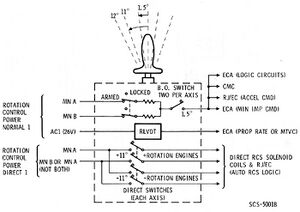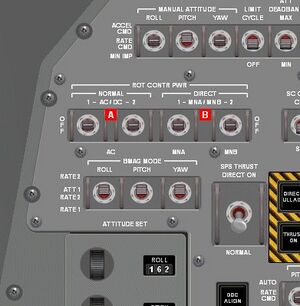Rotation Hand Controller: Difference between revisions
imported>Tschachim (Work in progress...) |
imported>Tschachim (... done for now) |
||
| Line 12: | Line 12: | ||
* '''Direct Switches''' - Direct switches will close whenever the RHC is moved a nominal 11.5° from its null position (about 92% of total deflection). Direct switch closure will produce acceleration commands through the RCS direct solenoids. | * '''Direct Switches''' - Direct switches will close whenever the RHC is moved a nominal 11.5° from its null position (about 92% of total deflection). Direct switch closure will produce acceleration commands through the RCS direct solenoids. | ||
== Power supply == | == Power supply == | ||
| Line 29: | Line 27: | ||
The RHC breakout switches are powered with DC power if either or both of the ROT CONTR PWR DIRECT 1 or 2 switches {{Panel label|name=B}} are switched to MNA/MNB or the ROT CONTR PWR DIRECT 1 switch is switched to MNA or the ROT CONTR PWR DIRECT 2 switch is switched to MNB<cite>III</cite>. | The RHC breakout switches are powered with DC power if either or both of the ROT CONTR PWR DIRECT 1 or 2 switches {{Panel label|name=B}} are switched to MNA/MNB or the ROT CONTR PWR DIRECT 1 switch is switched to MNA or the ROT CONTR PWR DIRECT 2 switch is switched to MNB<cite>III</cite>. | ||
== Joystick and Orbiter's controls support == | |||
Rotational control is provided by joysticks or Orbiter's attitude controls. In case of joysticks, the [[Launchpad Configuration Options]] allow the use of one or two joysticks. If only one joystick is configured, it acts as RHC or [[THC]] depending on Orbiter's attitude control mode. The axes of the real RHC are the same as the axes of a typical 3-axes joystick. | |||
With the '''"Use Orbiter controls as RHC/THC"''' option enabled in the [[Launchpad Configuration Options]], the Orbiter controls (keyboard, joystick etc. as you have configured it) are used as input for the RHC while in Orbiter's rotational attitude mode. In this case Orbiter's joystick axes and keys assignments to the rotational movements of the spacecraft apply. | |||
When a digital control like a keyboard is used as RHC input, an attitude command is simulated as full deflection, i.e. both the brakeout and the direct switches are closed and the transducers produce full signal strength. | |||
With this option disabled, rotational thruster firing with the [[w:numeric keypad|numeric keypad]] or a joystick enabled in Orbiter is possible but unrealistic. In this case Orbiter controls the thrusters directly without using the auto or direct thruster control coils, so this is still working without electrical power, disabled coils etc. The RCS thrusters still need proper fuel supply though. | |||
<biblio force=false> | <biblio force=false> | ||
| Line 37: | Line 44: | ||
</biblio> | </biblio> | ||
==External Links== | |||
* [http://ntrs.nasa.gov/archive/nasa/casi.ntrs.nasa.gov/19750010202_1975010202.pdf Apollo experience report: Crew Station Integration. Volume 3: Spacecraft Hand Controller Development] | |||
[[Category:Stabilization and Control System]] | [[Category:Stabilization and Control System]] | ||
Revision as of 21:46, 4 June 2008
The Rotation Hand Controller (RHC) provides the capability of manual control of spacecraft rotation in either direction about each axis. Also the RHC may be used for manual thrust vector control (see SPS). In the real CSM there were two identical Rotation Hand Controllers, in Project Apollo - NASSP both are simulated simultaneously by using one joystick or Orbiter's attitude controls (joystick, keyboard) when configured with the Launchpad Configuration Options.
RHC commands

The axes of the real RHC are the same as the axes of a joystick, so if a joystick is configured it can be used as usual. In case of Orbiter's attitude controls they are used as configured in Orbiter. Within the RHC there are three command sources per axis:
- Breakout Switches - A switch closure occurs whenever the RHC is moved 1.5° from its null position (about 12% of total deflection). Separate switches are provided in each axis and for each direction of rotation. These six breakout switches are used to provide: command signals to the CMC, SCS minimum impulse and acceleration commands, BMAG cage signals and proportional rate command enabling.
- Transducers - Transducers produce AC signals proportional to the RHC displacement from the null position. These signals are used to command spacecraft rotation rates during SCS proportional rate mode and to command SPS engine gimbal position during Manual Thrust Vector Control (MTVC).
- Direct Switches - Direct switches will close whenever the RHC is moved a nominal 11.5° from its null position (about 92% of total deflection). Direct switch closure will produce acceleration commands through the RCS direct solenoids.
Power supply

An RHC needs to be powered before it can be used, of course. Since the simulated RHC is both RHC 1 and 2, the simulated RHC is working if either or both RHCs are powered. The power for the direct switches is independant of the normal power supply.
Normal power
The RHC breakout switches are powered with DC power if either or both of the ROT CONTR PWR NORMAL 1 or 2 switches A are switched to AC/DCI. The transducers are powered with AC power if either or both of the ROT CONTR PWR NORMAL 1 or 2 switches A are switched to AC/DC or ACII.
Direct power
The RHC breakout switches are powered with DC power if either or both of the ROT CONTR PWR DIRECT 1 or 2 switches B are switched to MNA/MNB or the ROT CONTR PWR DIRECT 1 switch is switched to MNA or the ROT CONTR PWR DIRECT 2 switch is switched to MNBIII.
Joystick and Orbiter's controls support
Rotational control is provided by joysticks or Orbiter's attitude controls. In case of joysticks, the Launchpad Configuration Options allow the use of one or two joysticks. If only one joystick is configured, it acts as RHC or THC depending on Orbiter's attitude control mode. The axes of the real RHC are the same as the axes of a typical 3-axes joystick.
With the "Use Orbiter controls as RHC/THC" option enabled in the Launchpad Configuration Options, the Orbiter controls (keyboard, joystick etc. as you have configured it) are used as input for the RHC while in Orbiter's rotational attitude mode. In this case Orbiter's joystick axes and keys assignments to the rotational movements of the spacecraft apply.
When a digital control like a keyboard is used as RHC input, an attitude command is simulated as full deflection, i.e. both the brakeout and the direct switches are closed and the transducers produce full signal strength.
With this option disabled, rotational thruster firing with the numeric keypad or a joystick enabled in Orbiter is possible but unrealistic. In this case Orbiter controls the thrusters directly without using the auto or direct thruster control coils, so this is still working without electrical power, disabled coils etc. The RCS thrusters still need proper fuel supply though.
<biblio force=false>
#I The ROT CONTR PWR NORMAL switches receive DC power from both the SCS CONTR/AUTO MNA and MNB circuit breakers on panel 8. #II The ROT CONTR PWR NORMAL 1 switch receives AC power from the SCS AC1 circuit breakers on panel 8, the ROT CONTR PWR NORMAL 2 switch receives AC power from the SCS ECA/TVC AC2 circuit breakers on panel 8. For both switches the ECA needs to be powered, too. #III The ROT CONTR PWR DIRECT 1 switch receives DC power from either both the SCS CONTR/DIRECT 1 MNA and MNB circuit breakers on panel 8 when switched to MNA/MNB or only from the SCS CONTR/DIRECT 1 MNA circuit breaker on panel 8 when switched to MNA. The ROT CONTR PWR DIRECT 2 switch receives DC power from either both the SCS CONTR/DIRECT 2 MNA and MNB circuit breakers on panel 8 when switched to MNA/MNB or only from the SCS CONTR/DIRECT 2 MNB circuit breaker on panel 8 when switched to MNB. #References
</biblio>